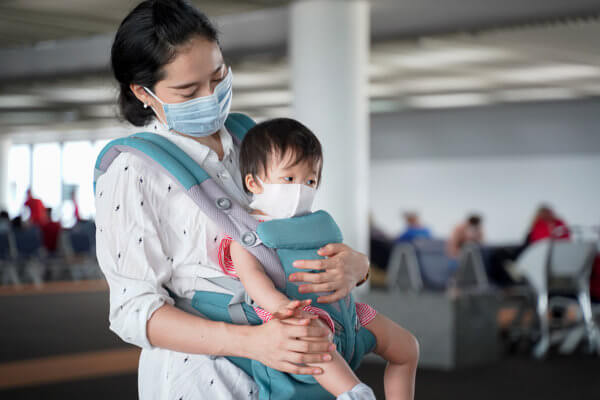Here is the latest parenting news you should know about:
Chicken Pox Vaccinations Unbundled
No one likes to see a baby cry, which is why a “super” vaccine like MMRV that combines two vaccines—one for measles, mumps and rubella (“MMR”) and another one for chicken pox (aka varicella, or “V”)—into a single shot sounds appealing. Just one catch: A large-scale study published in the journal Pediatrics found that toddlers who got the MMRV shot were twice as likely to experience a febrile seizure seven to 10 days after vaccination as those who got separate vaccines for MMR and chicken pox on the same day.
Typically administered between ages 1 and 2, the MMR and chicken pox vaccines protect against four serious diseases. Febrile seizures, or convulsions brought on by fever, are potential side effects. Although very scary, they are usually harmless and don’t lead to epilepsy, says lead investigator Nicola Klein, MD, PhD, co-director of the Kaiser Permanente Vaccine Study Center in Oakland, Calif. But based in part on her study, the Centers for Disease Control and Prevention (CDC) now recommend that the MMR and chicken pox vaccines be given separately to toddlers receiving their first dose unless a parent specifically requests the MMRV shot. Klein advises weighing the options with your pediatrician before deciding for yourself.
—Stacy Whitman
Educational Slumber
New parents often marvel at how much their newborn babies sleep (as many as 16 to 18 hours a day!). Perhaps even more astonishing: A new study shows our sleeping beauties may be learning as they snooze. Researchers at Columbia University Medical Center monitored the eye movements and brain waves of 1- and 2-day-old slumbering infants. Twenty-six babes were exposed to a soft tone, followed by a gentle puff of air to the eyelids, in an exact pattern that was repeated for 20 minutes.
At the end of the test, all but two squeezed their eyelids together when the tone was played without the puff of air, indicating that they had learned to predict the relationship between the two stimuli. Their brain waves also showed activity in the frontal area of the cerebral cortex that is involved with memory. According to lead researcher William Fifer, PhD, the findings, which appeared in the journal Proceedings of the National Academy of Sciences, could lead to comprehensive early screening tests for developmental disorders such as autism and dyslexia.
—Stacy Whitman
Breastfeeding for Fever Prevention
Breastfeeding is known to provide numerous benefits to babies, including protection from diseases ranging from asthma to diabetes. Now, there may be a new one to add to the list. Recent research published in the journal Pediatrics shows that breastfed infants are less likely to develop fevers in the days following a vaccination. Fever is a common result of immunizations—and while typically mild and brief, it can make a baby uncomfortable and interfere with his sleep.
In the study, only 25 percent of exclusively breastfed and 31 percent of partially breastfed infants got fevers compared with 53 percent of those who received no breast milk. The researchers speculate that anti-inflammatory substances in human milk may help prevent a temperature spike. Another theory: After getting a shot, nursing babies may turn to the breast for comfort, and the resulting caloric intake may help ward off fever.
—Stacy Whitman
Whip Whooping Cough
Last year more than 6,000 cases of the bacterial respiratory infection whooping cough (aka pertussis) were reported—and claimed the lives of 10 infants—in California alone. Newborns are more at risk for complications for the highly contagious illness because of their immature immune systems and the small size of their air passages, says Lauren Feder, MD, Los Angeles–based physician and author of Natural Baby and Childcare and The Parents’ Concise Guide to Childhood Vaccinations. So whether or not you’re in the Golden State, take these steps to protect your little peanut:
Vaccinate, vaccinate, vaccinate. Kids need five doses of the DTaP (diphtheria, tetanus and pertussis) vaccine—at 2, 4, 6 and 15 to 18 months, and when 4 to 6 years old. Everyone else (11 years and up) should get the TDaP (tetanus, diphtheria and pertussis) booster—particularly new moms who aren’t yet immunized, and anyone else who comes into contact with infants.Share your immunity. Moms can strengthen newborns’ systems in several ways. “Breastfeeding is important—ideally for at least a year,” says Dr. Feder. Baby vitamin C and probiotics could help as well.
Steer clear of symptomatic people. Most people don’t realize they have pertussis—which usually begins with cold-like symptoms (runny nose and sneezing) and progresses to a gasping cough—so avoid anyone who’s even slightly under the weather. And if you or your child isn’t feeling well, it’s best to stay home.
—Alexa Joy Sherman
Flu Shots for Your Fetus
Infants can’t get vaccinated for influenza until they’re 6 months old—leaving them unprotected at a time when they’re particularly vulnerable to illness—but research continues to confirm that pregnant women can protect their babies before they’re even born. According to a February 2011 Archives of Pediatrics & Adolescent Medicine study, infants whose mothers got a flu shot while pregnant decreased their newborns’ risks for confirmed flu, as well as for hospitalization from flu-like symptoms, by about 40 percent. Previous studies, including one from the Yale School of Medicine in 2009 and another from Johns Hopkins University in 2008, documented even greater levels of protection.
“We urge all pregnant women, and women who expect to become pregnant, to get their influenza immunization,” says Jennifer Howse, PhD, president of the March of Dimes. Oh, and research—including the aforementioned Yale study—suggests that obstetricians aren’t used to offering flu shots, so make sure you request it from your doc.
—Alexa Joy Sherman
Beyond Ice Chips
Until now, restrictions on food and liquids—even water—during labor have been imposed to reduce the likelihood of aspiration, should a woman need to be anesthetized for a cesarean delivery. But a 2010 Cochrane review of five studies identified no benefits or harms to restricting foods and fluids for women at low risk of needing anesthesia. “Given these findings, women should be free to eat and drink in labor, or not, as they wish,” wrote the authors.
However, the American College of Obstetricians and Gynecologists (ACOG) and the American Society of Anesthesiology (ASA) still say birthing moms and munchies don’t mix—and continue to advise against eating solids during labor. Thus far, ACOG has only gone so far as to relax its guidelines on fluids and, since 2009, has allowed women with a normal, uncomplicated labor to drink small amounts of clear liquids including water, soda, tea, black coffee and sports drinks. So…um, cheers!
—Alexa Joy Sherman
The Doctor Is In
Having a new baby may make you wish you had a personal physician on hand to answer every last question. Enter The Portable Pediatrician: Everything You Need to Know About Your Child’s Health by America’s trusted baby experts William Sears, MD; Martha Sears, RN; James Sears, MD; and Peter Sears, MD. The one-stop reference guide covers almost 200 conditions from acne to whooping cough, spanning from infancy to the teenage years. It also includes valuable advice on nutrition, skincare and brain development—plus the very latest research on vaccines—that could help prevent your child from getting sick in the first place.
— Stacy Whitman
See what pediatricians are abuzz about.




